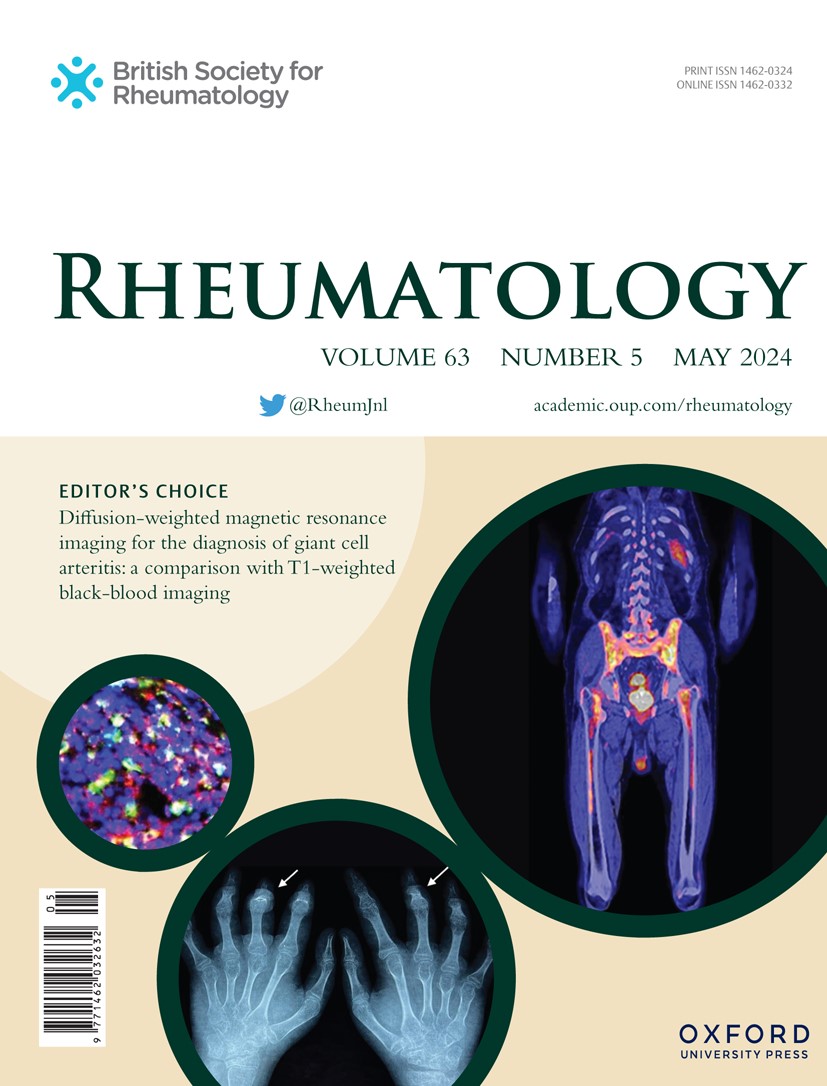系统性红斑狼疮的一种新的characteristıc:亚临床静脉受累-深入的生化和影像学研究。
IF 4.4
2区 医学
Q1 RHEUMATOLOGY
引用次数: 0
摘要
系统性红斑狼疮(SLE)是一种异质性自身免疫性疾病,常并发血管事件,伴或不伴抗磷脂抗体综合征(APS)。本研究旨在通过生化和成像方式探讨SLE的亚临床静脉病变,重点关注静脉壁厚度(VWT)和炎症相关生物标志物。方法在横断面研究中,根据抗磷脂抗体(APA)状态和临床APS对68例SLE患者进行分类。结果将22例类风湿关节炎(RA)患者与20例健康对照进行比较。ELISA法检测血清p选择素、生长分化因子15 (GDF15)、瓜氨酸组蛋白3 (CH3)水平。超声评估双侧颈静脉、股静脉、门静脉和股动脉的VWT。对血管变化的相关性和预测因素进行统计学分析。结果与对照组相比,SLE患者的vwt显著增加(p< 0.001),无论APA和APS状态如何。slea - aps患者血清p -选择素、GDF15和CH3水平升高。GDF15水平与VWT呈正相关,门静脉壁厚度增加与血栓形成独立相关。生物标志物显示与APS显著相关,提示其作为血栓形成前状态指标的作用。血管参数与疾病活动度评分之间无明显关联。结论:亚临床静脉受累似乎是SLE的一种新的血管特征,反映在静脉壁厚度(VWT)增加及其与血栓形成和生物标志物的关联上。门静脉厚度增加可能提示血管危险。这些变化是由炎症还是血管重塑引起的尚不清楚,但它们的存在与疾病活动无关,这突出了它们的临床相关性。本文章由计算机程序翻译,如有差异,请以英文原文为准。
A new characteristıc of systemic lupus erythematosus: subclinical vein involvement-an in-depth biochemical and imaging study.
OBJECTIVES
Systemic lupus erythematosus (SLE) is a heterogeneous autoimmune disorder often complicated by vascular events, with or without antiphospholipid antibody syndrome (APS). This study aimed to explore subclinical venous involvement in SLE using biochemical and imaging modalities, focusing on vein wall thickness (VWT) and inflammation-related biomarkers.
METHODS
In this cross-sectional study, 68 SLE patients were categorized based on antiphospholipid antibody (APA) status and clinical APS. Results were compared with 22 rheumatoid arthritis (RA) patients and 20 healthy controls. Serum levels of P-selectin, growth differentiation factor 15 (GDF15), and citrullinated histone 3 (CH3) were measured using ELISA. Ultrasonographic assessments evaluated VWT at bilateral jugular veins, femoral veins, portal vein and femoral artery. Correlations and predictors of vascular changes were analyzed statistically.
RESULTS
VWT was significantly increased in SLE patients compared with both control groups (p< 0.001), regardless of APA and APS status. Serum P-selectin, GDF15, and CH3 levels were elevated in SLE-APS patients. GDF15 levels correlated positively with VWT, and increased portal vein wall thickness was independently associated with thrombosis. Biomarkers showed significant associations with APS, suggesting their role as indicators of prothrombotic states. No significant associations were found between vascular parameters and disease activity score.
CONCLUSION
Subclinical venous involvement appears to be a novel vascular feature of SLE, reflected by increased vein wall thickness (VWT) and its association with thrombosis and biomarkers. Increased portal vein thickness may indicate vascular risk. Whether these changes result from inflammation or vascular remodeling remains unclear, but their presence irrespective of disease activity highlights their clinical relevance.
求助全文
通过发布文献求助,成功后即可免费获取论文全文。
去求助
来源期刊

Rheumatology
医学-风湿病学
CiteScore
9.40
自引率
7.30%
发文量
1091
审稿时长
2 months
期刊介绍:
Rheumatology strives to support research and discovery by publishing the highest quality original scientific papers with a focus on basic, clinical and translational research. The journal’s subject areas cover a wide range of paediatric and adult rheumatological conditions from an international perspective. It is an official journal of the British Society for Rheumatology, published by Oxford University Press.
Rheumatology publishes original articles, reviews, editorials, guidelines, concise reports, meta-analyses, original case reports, clinical vignettes, letters and matters arising from published material. The journal takes pride in serving the global rheumatology community, with a focus on high societal impact in the form of podcasts, videos and extended social media presence, and utilizing metrics such as Altmetric. Keep up to date by following the journal on Twitter @RheumJnl.
 求助内容:
求助内容: 应助结果提醒方式:
应助结果提醒方式:


